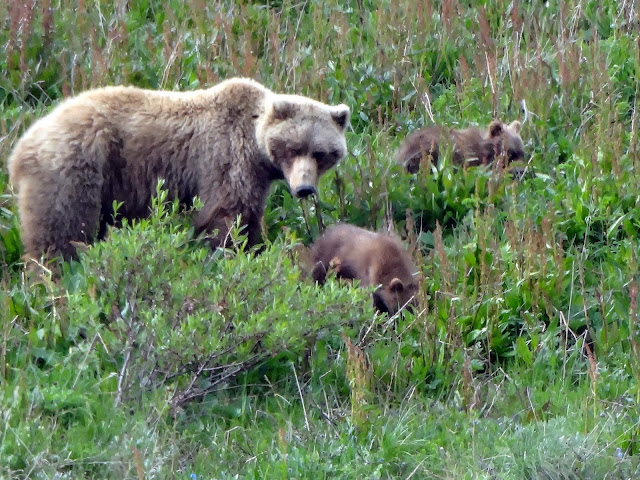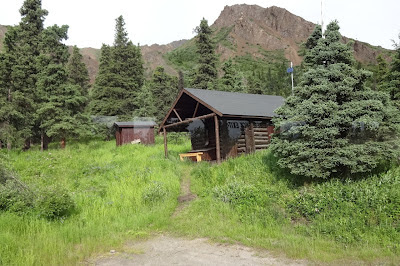Within Denali, Toklat River will always have a special
significance, as it was the location where naturalist Charles Sheldon
built a cabin and was so moved that he fought to preserve the land. So
moved by the area, Sheldon moved back east and spent nine years lobbying
to create Alaska’s first national park.
Originally named Mount McKinley National Park, it was renamed in 1980 to Denali, which means “the great one.” The first recorded attempt to climb it was in 1903, yet Mt. McKinley was not successfully climbed until 1963.
Originally named Mount McKinley National Park, it was renamed in 1980 to Denali, which means “the great one.” The first recorded attempt to climb it was in 1903, yet Mt. McKinley was not successfully climbed until 1963.
Our group boarded a bus a bit after 8 a.m. to take a 7 to 8 hour trip through the park. We had a wonderful guide who told us a lot about the park as we road. She is a teacher in Idaho during the school year and has come to Alaska for more than 12 years to do these guided tours.
Since the park is so big, there is no guarantee that we would see animals on our trip. Also, only 30% of the people who go through the park (and the #s are limited) get to see Mt. McKinley/Denali.
Unfortunately my notes are not with me in California. If I have time, I will add to this blog when I get home.
 |
| Near the entrance of the park |
 |
| Savage Park Ranger Station need entrance |
 | |
| Toward the mountains on a cloudy morning |
 |
| Small scrubby plants in tough terrain |
 |
| remnants of frozen land |
You can get a lot of information on the park by going to its website:
http://www.nps.gov/dena/index.htm
Meanwhile, enjoy the photos!
You can see from the chart below that the bus went through a variety of altitudes and terrain as we went on much of the road in the park.
The map below shows you the topography of the road:
We had our first view of animals when we saw a number of Dall sheep, high up on the hills to our right.
A while later we were in for a real treat! A mother grizzly bear and her two cubs were just below the road on the left side of the bus. The driver stopped at the side of the road; we closed all windows, and were very quiet. We watched the 3 animals for 15 minutes in awe. It was quite a treat! The first view of the sow was of her tush and we only saw one cub. It is normal for a sow to have 2 or 3 cubs, but often the third does not make it.
The picture below really shows how close they were to the bus as you can see the rim of the window at the bottom of the picture. I did use the zoom a bit on the picture, so you do not see the road in the photo, but she still was amazingly close. The sow probably grew up near the road and is used to having buses nearby.
In the picture below you can see all 3 bears--finally. The cubs looked so cute. They were quite young.
 |
| One last shot of the three |
Here is some information on the program.
 |
| Picture of an artist-in-residence from 2002 |
and had 15 minutes to view the area and climb a path up a hill. Here was the view from the hill. You can see the bus in the lower right of the photo.
There are not a lot of flowers and most are small, but here were a few.
Here is a plant growing at the foot of a rock.
 | |
| Another view from the hill |
 |
| Close up of the hills in the distance |
 |
| Another colorful flower |
Then we saw some caribou....quite high up the hill so the pictures are fuzzy.
 |
| Food for bigger animals |
 |
| More Flowers |
 | |
| Moose Antler on a bench outside |
 |
| Grizzley BearScat |
 |
| Cast of Bear Paw Print |
 |
| Caribou w live, furry antlers |
On the way back we saw this little guy on a hill named for his species as they often sit on it.
 |
| Marmot on Marmot Hill/Rock |
We saw the same momma bear and her cubs on our way back. They were far away from the road and up a hill a bit.
 |
| More Flowers |
 |
| Mt McKinley/Denali appearing |
So we were very lucky. Given the huge size of the park and the limited scope of the roads, we did see quite a few animals. (The only major animal we didn't see was a moose.) AND we were able to see the mountain. We had the opportunity to see the park and very much appreciated the fact that animals really had the space they needed to be at home in nature. We had a great guide who provided a running commentary and we also had very sore tushes from sitting so long!
At the visitors' center near the park, there was a lot to see. Off to the side we also went to the Murie Science and Learning Center, a very small place. There was interesting information on dinosaurs in the park.
























No comments:
Post a Comment